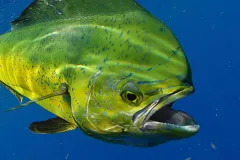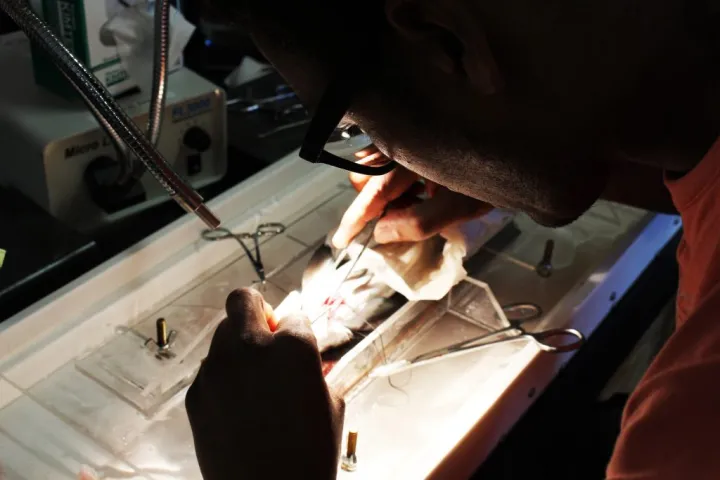Fish Heart Out of Water

Under the lens of a microscope—in a shallow, glass well—spindly orbs pulse at regular intervals. They are, in fact, heart cells from a mahi-mahi fish, specially prepared with the precision and care required of a surgeon. A quick succession of shocks administered by fish scientist Dr. Rachael Heuer prompts the cells to contract just as they would in a fully functioning heart. But for Heuer, the interesting moment comes next. At the push of a button she administers low levels of oil, and suddenly the heart cells aren’t the peppy, pumping machines of a few moments ago.
In 2010, the Deepwater Horizon oil spill spewed over 3 million barrels of oil into the Gulf of Mexico, the home of many mahi-mahi. For scientists and fishermen, concerns about the oil’s impact on mahi-mahi populations became very real. The 1989 Exxon Valdez spill off the shores of Alaska may have prompted a delayed collapse in the Pacific herring population, an important fishery in the region. The collapse didn’t happen until years after the spill, indicating that the impacts of oil on fish are not as straightforward and immediate as once thought.
The fear was that a similar situation could impact the mahi-mahi and other ecologically and economically important fish in the Gulf of Mexico. According to NOAA landings data, over the last ten years, the mahi-mahi fishery supports a 6.3 million-dollar industry annually (on average) in the United States, and total fisheries revenue for all species in the Gulf of Mexico adds up to over 800 million dollars. After the Gulf of Mexico oil spill, scientists formed a research team called RECOVER (Relationships of Effects of Cardiac Outcomes in fish for Validation of Ecological Risk) funded by the Gulf of Mexico Research Initiative (GoMRI) in order to figure out how the oil might impact the health of fish in the Gulf.
Mahi-mahi (also known as the common dolphinfish or dorado) are some of the most impressive swimmers of the ocean. Heuer, based at the University of Miami, Florida, refers to them as “the little monsters of the sea” because of their endurance, power, and aggression. They can grow over four feet in their first year and a half, swim at speeds over 40 miles-per-hour, and make massive migrations across the ocean, sometimes up to 1,864 miles (3,000 km) in one month. When housed in an aquarium they are fed in the same manner as captured sharks— researchers must ensure they are always happily full, otherwise they are quick to turn on each other and become cannibalistic.
“They’re living life in the fast lane. It’s go, go, go all the time,” says Heuer. When placed in swim tunnels and forced to swim at their fastest, “It’s almost like looking at a hummingbird wing, how fast they’re fins are going. I can’t see the tails because they’re beating so fast.”
As highly aerobic swimmers, mahi-mahi rely on strong hearts to pump plenty of oxygen to their powerful muscles. A weak heart can be the difference between a full stomach and starvation or becoming the meal of a bigger predator. Previous studies have shown that oil exposure impacts the development of larval mahi-mahi hearts, causing them to beat with less force, improperly, or even fail entirely. Larvae are easy to study because they are transparent, so scientists can see heart deformities in a living fish. But the RECOVER team had a theory that even adult mahi-mahi hearts were harmed by low levels of oil.
One of the initial indicators that the oil might be impacting adult mahi-mahi hearts came from a study conducted by RECOVER teammate Derek Nelson. After being trained in open-heart surgery on reptiles as an undergraduate student at the University of North Texas, Nelson turned his focus to fish. With skilled precision, Nelson exposed the heart of the mahi-mahi and monitored the blood flow and pressure within the chambers of the fish’s heart.
“Once you get to the surgery you have to be aware of surrounding vessels. You’re talking about millimeters from one vessel to the other,” says Nelson.
By monitoring the heartbeat of a mahi-mahi while under sedation, Nelson was able to show that when exposed to oil for 24 hours, a young mahi-mahi’s heart loses its ability to efficiently pump blood throughout the body. The heart was hurt by even a day exposed to the oil.
This quick timeline led Heuer to suspect that something at the cellular level was impeding the heart’s ability to contract. Now, she just needed a way to see inside the cells. Trained as a fish physiologist, she turned to a procedure more commonly practiced with mice in the biomedical field.
To get at the heart cells, Heuer first needed to remove the heart from the fish without damaging or killing the organ—essentially, she needed to trick the heart into believing it was still within the body of the fish. At the same time, she needed to remove the residual blood so that she could easily view the individual heart cells. To accomplish this double feat, Heuer used a special solution that included sugars and nutrients to feed the heart cells but also wash away the blood.
The next step involved using a concoction of enzymes to break apart the tightly interwoven cells. Again, all while keeping the cells happy and alive. “There’s this theme of finding the sweet spot,” she says. Add too little of the enzyme and the heart cells clump together but add too much and the cells become shriveled as the cell walls themselves start to break apart. Next, the cells are mounted under a microscope, a bath of sugar and salt solution constantly flowing over them to keep them alive.
“There are a lot of parts that can go wrong,” says, Heuer. “If the cell is contracting up and down rather than side to side, I’m not going to get a good image.”
If the entire process goes as planned, Heuer can watch, in real time, the contraction of the heart cells. She can even get them to beat at the speed of her choosing by administering a pulsating electrical shock, a simulation of what naturally occurs in a living fish. Now, with healthy cells beating under Heuer’s watchful eye, varying concentrations of oil can be added to the flowing saline bath and the impact is recorded.
Hueur found that even the smallest addition of oil shortened the length at which the heart cells contracted. An adult mahi-mahi will show signs of impaired swimming when exposed to eight to ten micrograms of oil, while the heart cells decreased their contraction length by about 12 percent at only three micrograms. This shows that the living fish may have a defense mechanism, like adrenaline, that helps the heart combat the damage of the oil.
Now that it’s understood that even adult mahi-mahi can be harmed by a short exposure to oil, RECOVER scientists are turning their attention to other fish that live in the Gulf. Nelson is currently testing how oil exposure impacts the heart functioning of the red drum, this time with sensors implanted within the heart. Once the fish recover from the implantation surgery, Nelson exposes them to varying stressors and monitors not only the heart but other fight-or-flight responses in real time.
For Nelson, who grew up in a landlocked city, his first experience working with the powerful mahi-mahi fish was a bit of a shock and even elicited a few shrieks when handling them between the holding tank and laboratory. Now a seasoned researcher, he looks back at that initial experience fondly and speaks with a clear reverence for the large fish.
“I’ve gained a whole lot more respect for fish,” he says. “You look at this large fish and you see how powerful they can be, how quickly they accelerate, their color changes whenever they’re getting fed—these fish are beautiful.”
__
The Ocean Portal receives support from the Gulf of Mexico Research Initiative (GoMRI) to develop and share stories about GoMRI and oil spill science. The Gulf of Mexico Research Initiative (GoMRI) is a 10-year independent research program established to study the effect, and the potential associated impact, of hydrocarbon releases on the environment and public health, as well as to develop improved spill mitigation, oil detection, characterization, and remediation technologies.
For more information, visit http://gulfresearchinitiative.org


